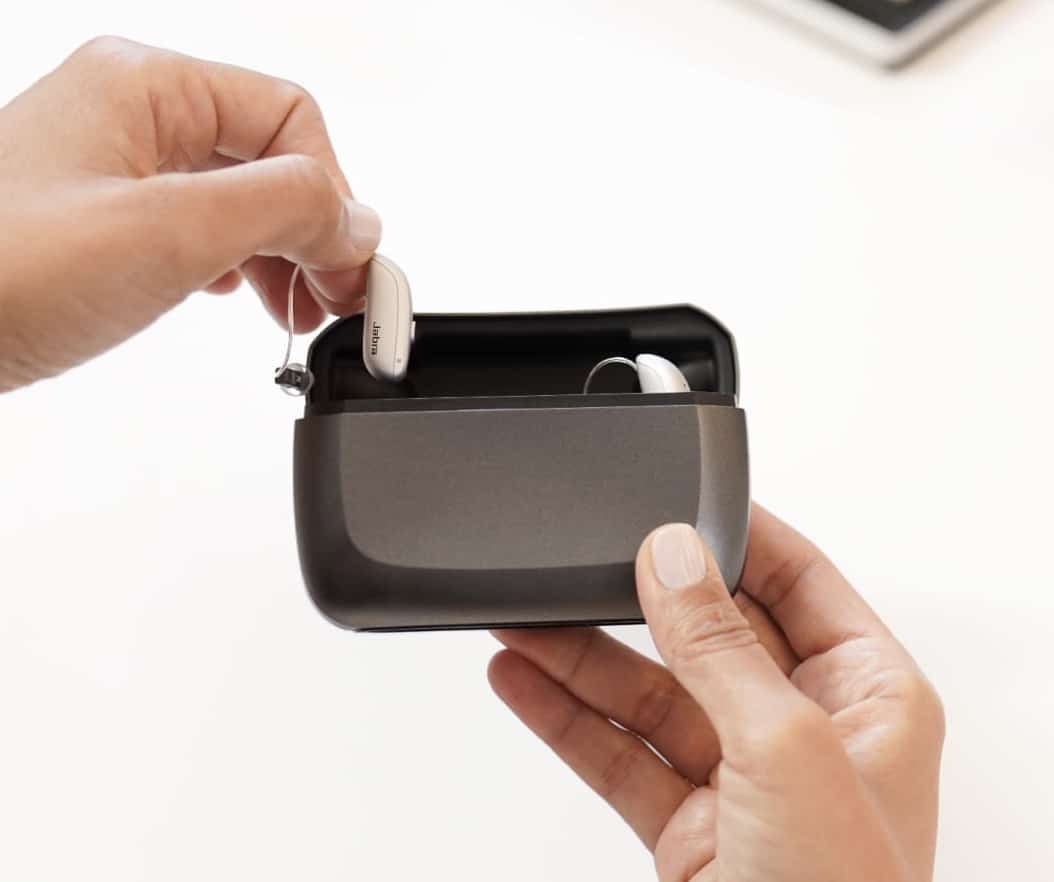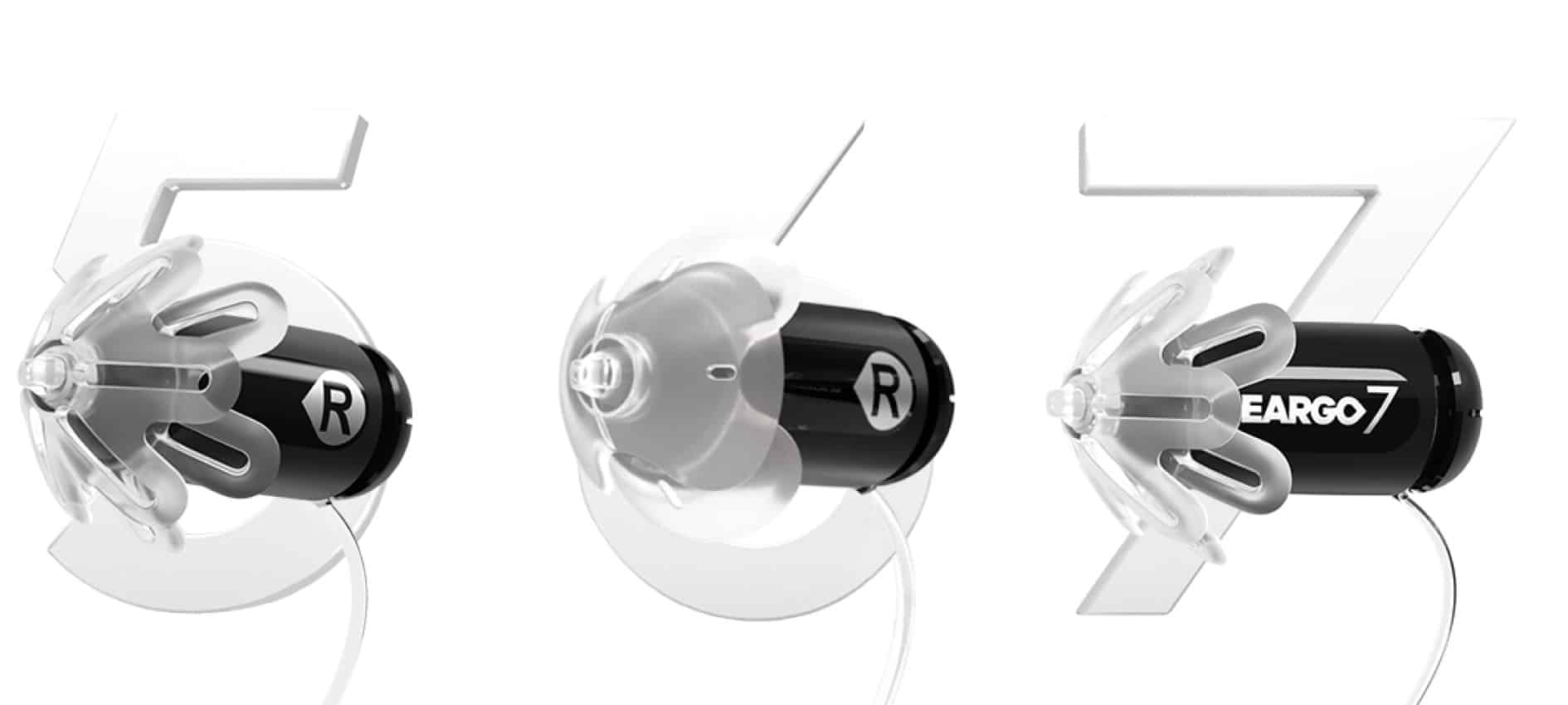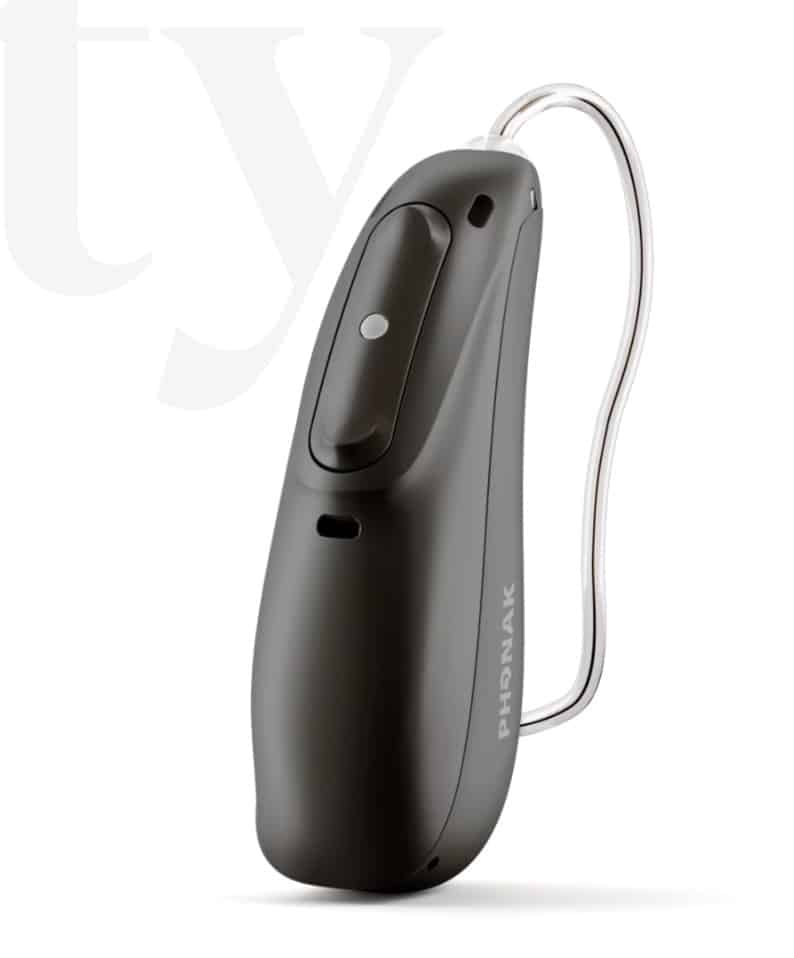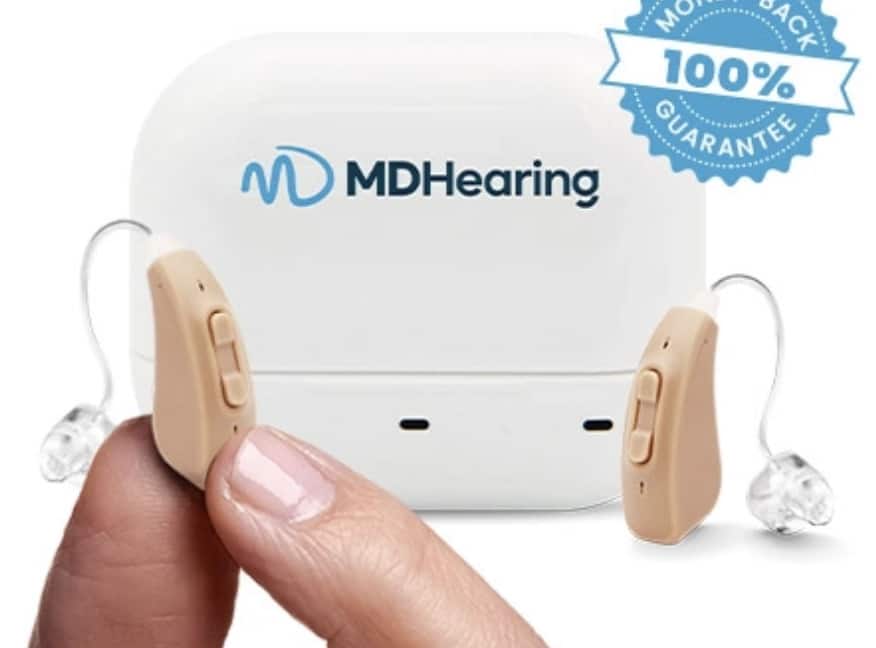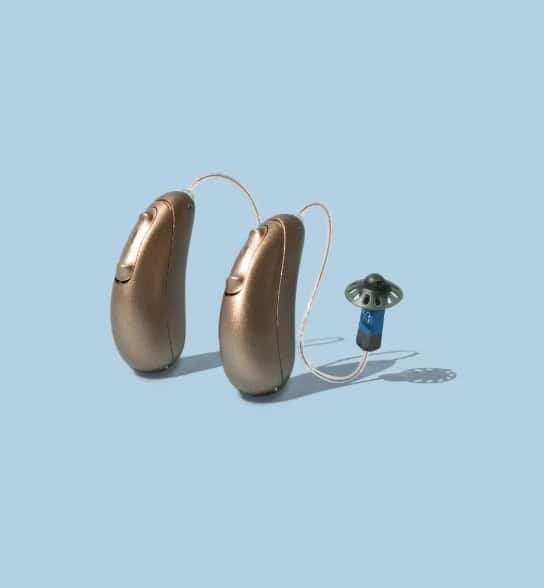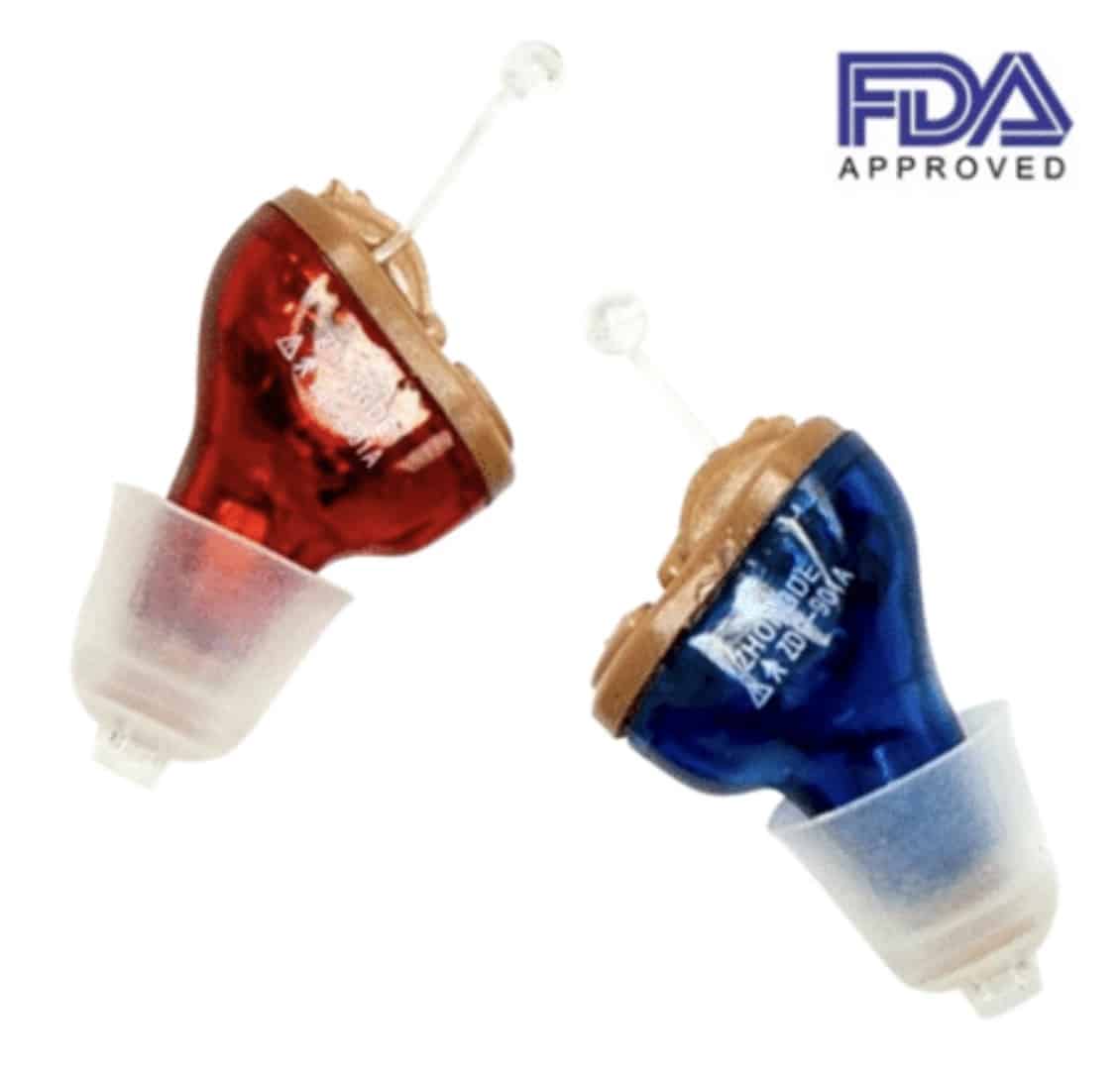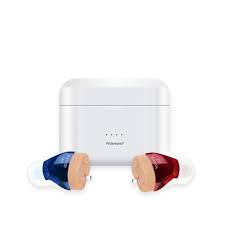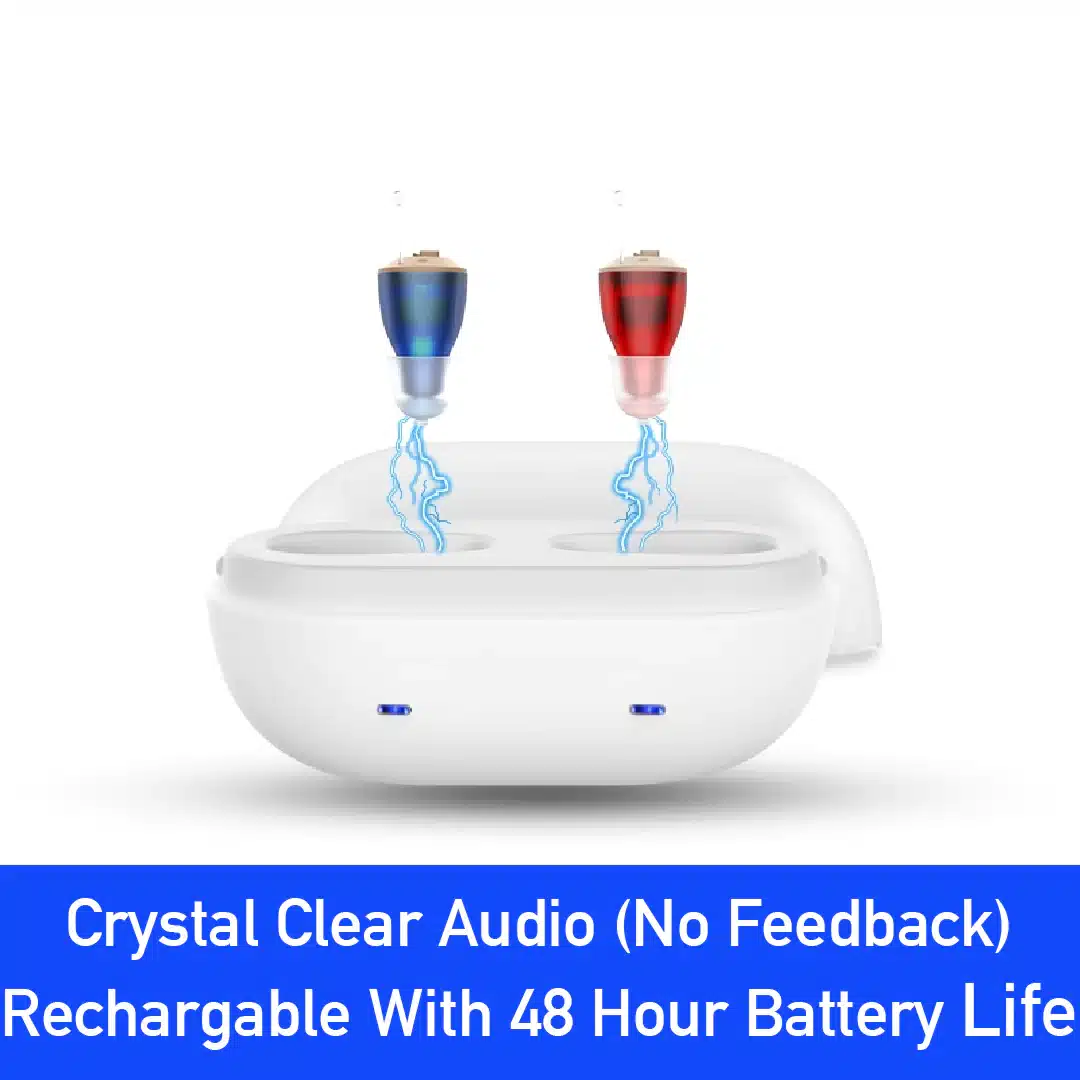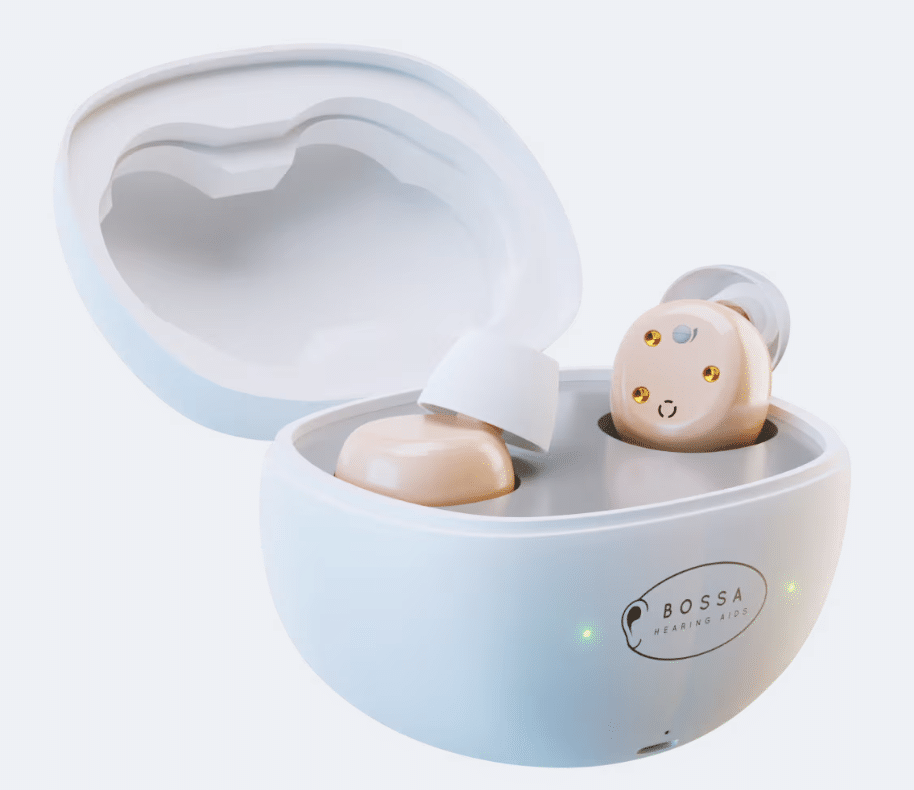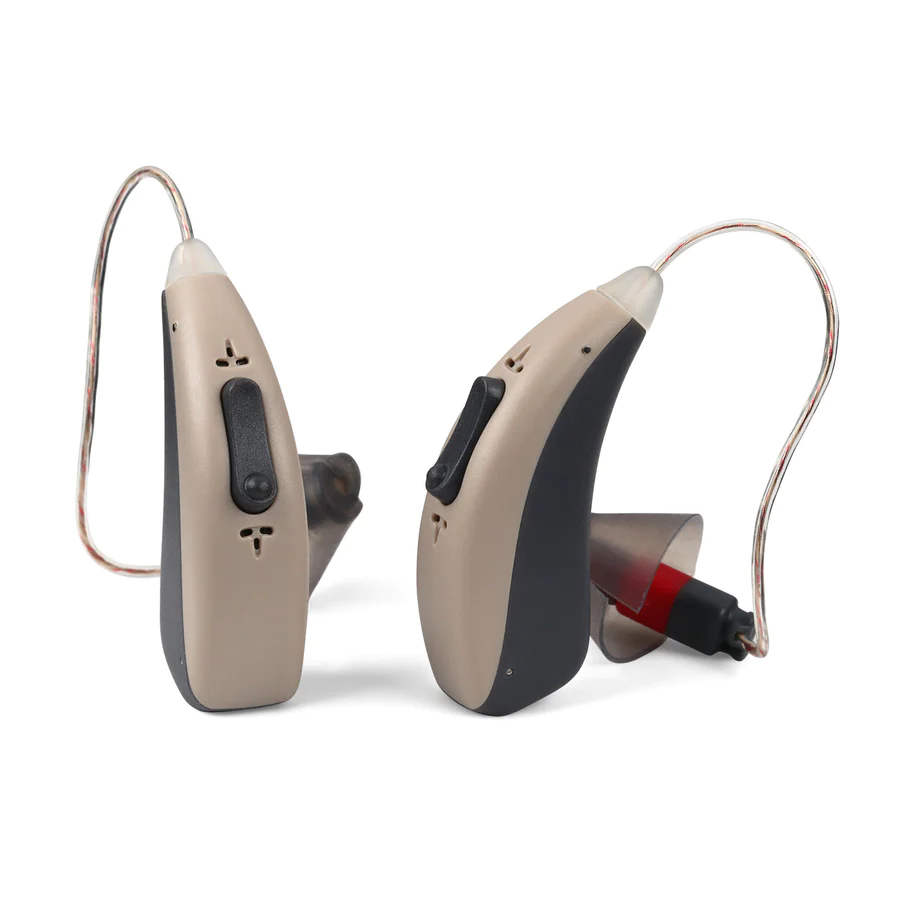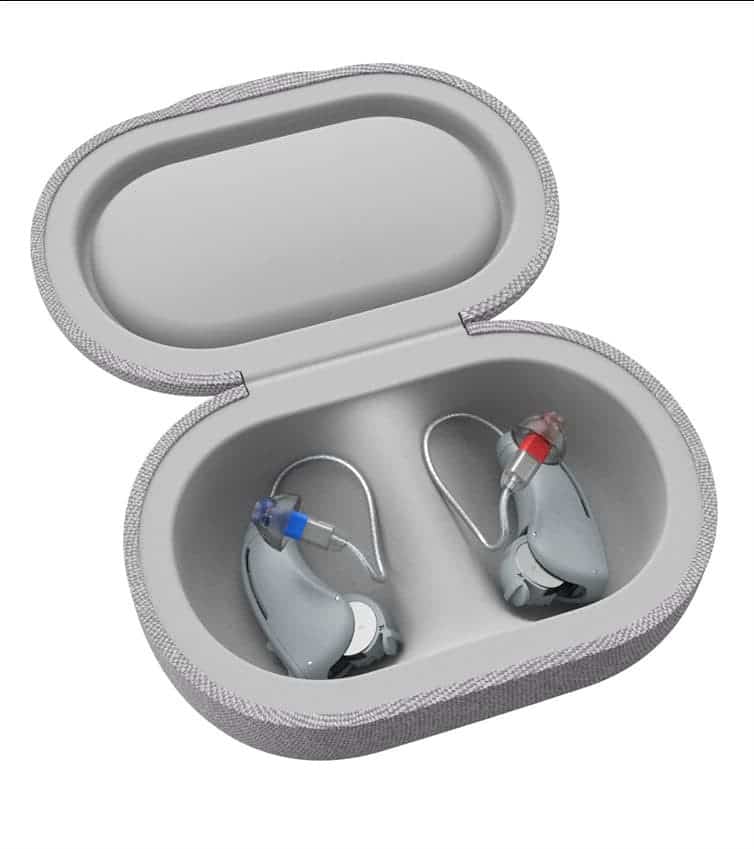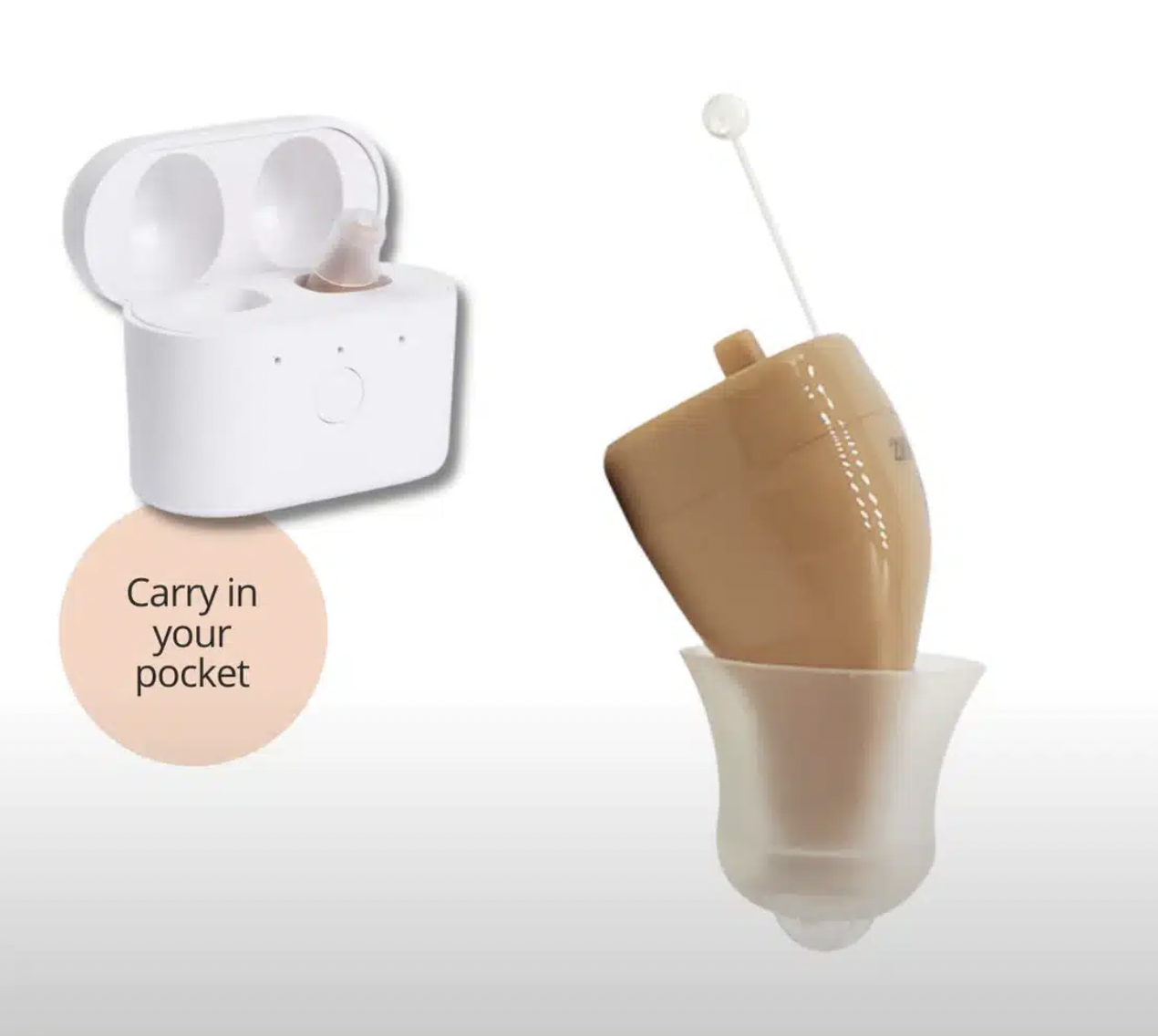Did you know that more than two-thirds of adults in the United States aged 70 and older have hearing loss? Researchers from Johns Hopkins University found this out. The good news is that hearing aids can significantly improve the quality of life for people with hearing problems. If you’re dealing with hearing loss and thinking about trying hearing aids, we’ve got all the information you need.
To help you find the best hearing aids, we asked several audiologists for their expert recommendations and tested 25 options on the market. Keep reading to discover which hearing aids made it onto our list of top choices.
Table of Contents
- 12 Best Hearing Aids
- What is a Hearing Aid?
- How Hearing Aids Work
- 5 Common Types of Hearing Aids
- How to Choose the Right Hearing Aids for You
- Possible Side Effects of Using Hearing Aids
- What Makes Digital Hearing Aids Different from Analog Ones?
- How long do hearing aids last?
- OTC vs. Prescription Hearing Aids: What You Need to Know
- What Level of Hearing Loss Calls for a Hearing Aid?
- How Can I Tell if I Require Hearing Aids?
- Which Hearing Aid Style is Right for You: In-the-Ear or Behind-the-Ear?
- How to care for your hearing aids
- How Much Do Hearing Aids Cost
12 Best Hearing Aids
1. The Jabra Enhance Select 200
The Jabra Enhance Select 200 is a modern over-the-counter hearing aid designed for improved hearing. It offers Bluetooth connectivity, smart sound technology, extended battery life, and two purchase options: Premium and Basic. Users can enhance their hearing experience using a user-friendly app, and it’s readily available without a prescription.
Pros:
- Bluetooth for easy device connectivity.
- Smart technology for natural sound and background noise reduction.
- Long battery life, up to 30 hours on a full charge.
- Premium option includes custom programming, support, and a three-year warranty.
- Basic option is more affordable with a one-year warranty.
- User-friendly app for settings, music, and calls.
- Over-the-counter availability with payment options.
Cons:
- May not be suitable for severe hearing loss.
- Premium option can be costly compared to Basic.
- Requires regular charging for extended use.
2. The Eargo 7
The Eargo 7 is a discreet and modern rechargeable hearing aid designed for comfort and convenience. It features automatic sound adjustments, a longer warranty, quick charging, and a self-fitting option. However, it’s best suited for mild to moderate high-frequency hearing loss.
Pros:
- Discreet and small design
- Comfortable with a unique petal-shaped tip
- Automatic sound adjustments for various environments
- Extended two-year warranty with unlimited repairs and one-time replacement
- Quick four-hour charging for up to 16 hours of use
- Convenient charging case for on-the-go power
- Self-fitting feature for easy setup
- 45-day risk-free trial period
Cons:
- Not suitable for severe hearing loss; best for mild to moderate high-frequency loss
3. The Phonak Audéo Lumity
The Phonak Audéo Lumity is a top-notch hearing aid designed for active individuals seeking improved hearing capabilities. It boasts waterproofing, AI-driven speech enhancement, and versatile connectivity options, making it an appealing choice for various situations.
Pros:
- Waterproof (IP68) for water and humidity tolerance.
- AI-driven SmartSpeech Technology enhances speech clarity.
- StereoZoom 2.0 reduces background noise, improving focus.
- SpeechSensor identifies speech direction for easier conversations.
- Bluetooth connectivity for seamless audio streaming and control via the myPhonak app.
- Compatibility with Roger microphones for large gatherings or long-distance listening.
Cons:
- Individual experiences may differ based on hearing needs and preferences.
4. The MDHearing AIR
The MDHearing AIR is an affordable hearing aid designed to improve hearing quality. It meets medical standards, reduces background noise, and cancels feedback. Lifetime support is available, and it comes with a 45-day money-back trial. There’s also an optional protection plan for $9.99/month. However, it’s visible behind the ear and lacks app compatibility, requiring manual volume adjustments.
Pros:
- Affordable hearing aid.
- Meets medical standards.
- Reduces background noise.
- Cancels feedback.
- Lifetime support from professionals.
- 45-day money-back trial.
- Optional protection plan available.
Cons:
- Somewhat visible behind the ear.
- No compatibility with the MDHearing app.
- Requires manual volume adjustments.
5. The Audicus Omni Series 2
The Audicus Omni Series 2 is an advanced over-the-counter hearing aid offering enhanced hearing, customization, and support. It is known for its smaller size, improved sound quality, and versatile connectivity. However, its pricing is per ear, and additional services come with extra costs.
Pros:
- Enhanced Hearing
- Customization Options
- Faster Sound Chip
- Bluetooth Connectivity
- Suitable for Various Hearing Needs
Cons:
- Price Listed Per Ear
- Additional Costs for Services
Learn more: Audicus Spirit Hearing Aid Review
6. HearTech Labs Invisible Hearing Aid
The HearTech Labs Invisible Hearing Aid is a discreet device designed for individuals with mild to severe hearing loss. It fits snugly into the ear canal, remaining virtually invisible. Using advanced technology, it captures sounds through microphones, processes them with an amplifier chip, and delivers tailored digital signals to the user’s ears through speakers, resulting in clearer auditory experiences. It adjusts to various environments and features simple controls for volume adjustment and activation.
Pros:
- Discreet design that is nearly invisible.
- Customized amplification for individual hearing needs.
- Easy-to-use controls for volume adjustment and activation.
- Comfortable fit for extended wear.
- Cost-effective solution compared to other options.
Cons:
- May not fit individuals with exceptionally small ear canals.
- Battery life may be a concern for some users.
- Compatibility issues for specific medical conditions or hearing impairments.
To learn more, read the full review of HearTech Labs Invisible Hearing Aid.
7. Widersonic Hearing Aids
Widersonic Hearing Aids are small devices designed to help people hear better. They work by capturing sounds with built-in microphones, processing them digitally, and then amplifying them to the user’s preferences. These aids have customizable settings, including features like noise reduction and wind noise suppression, to enhance the listening experience. Widersonic offers a rechargeable option for convenience.
Pros:
- Clear sound amplification
- Discreet design
- Customizable settings for individual needs
- Advanced features like noise reduction
- Rechargeable option for convenience
Cons:
- Higher cost compared to traditional hearing aids
- Not suitable for profound hearing loss
To learn more, read the full review of Widersonic Hearing Aids.
8. Hearing Co Micro CIC Hearing Aids
The Hearing Co Micro CIC Hearing Aids are discreet and rechargeable devices designed to assist individuals with hearing difficulties. These advanced aids amplify external sounds using cutting-edge technology, providing feedback-free audio and enhancing clarity for conversations and music enjoyment. With a quick 4-hour charge, they offer up to 48 hours of continuous use, making them convenient for daily wear. Operating them is simple, with accessible controls for volume adjustment and an on/off switch.
Pros:
- Clear, feedback-free audio enhances conversations and music enjoyment.
- Discreet design ensures they’re almost invisible when worn.
- Rechargeable with a long battery life of up to 48 hours on a single charge.
- Comfortable fit with ultra-soft ear-tips, suitable for sensitive skin.
- Adjustable volume settings cater to various levels of hearing loss.
- Easy to operate, even for individuals with shaky hands.
- Cost-effective solution compared to other hearing aids on the market.
Cons:
- May not be suitable for individuals with profound hearing loss.
- Fine-tuning settings may require patience to find the perfect balance.
To learn more, read the honest review of Hearing Co Micro CIC Hearing Aids.
9. Bossa Hearing Aids
Bossa Hearing Aids are innovative devices designed to assist individuals experiencing various degrees of hearing loss. Equipped with the advanced 2023 X5 Microchip, these aids capture sounds from all directions, process them to enhance clarity while reducing background noise, and deliver the refined sounds through comfortable earpieces or speakers. They offer versatility by managing tinnitus and allowing users to customize settings for different environments, providing a user-friendly solution for improved hearing.
Pros:
- Cutting-edge technology with the 2023 X5 Microchip.
- Effective in capturing faint sounds and reducing background noise.
- Versatile for managing tinnitus and customizable settings.
- Comfortable fit with various ear tip sizes.
- Easy connectivity with devices like smartphones.
- Long battery life and portable charging case.
- Affordable pricing compared to traditional options.
- Positive reviews and testimonials.
Cons:
- May not be suitable for all types of hearing loss.
- Limited connectivity options in some models.
- User adjustments may be required for optimal settings.
To learn more, read the full review of Bossa Hearing Aids.
10. Neosonic Hearing Aids
Neosonic Hearing Aids are devices designed to help people with hearing loss hear more clearly. They work by using microphones to pick up sounds, an amplifier to make them louder, and a speaker to deliver the amplified sound to the user’s ears. These aids are easy to use: you simply insert them, turn them on, adjust the volume, and enjoy clearer hearing. Neosonic offers different models to fit different needs, and some even come with rechargeable batteries for convenience.
Pros:
- Affordable option for those with budget constraints.
- Provides clear and amplified sound for better hearing.
- Various models available to suit different levels of hearing loss.
- Some models feature rechargeable batteries, reducing the need for frequent replacements.
- Comfortable and user-friendly design.
Cons:
- Some users may require time to adjust to wearing hearing aids.
- Not suitable for all types of hearing loss.
- Individual experiences with effectiveness may vary.
To learn more, read the full review of Neosonic Hearing Aids.
11. Lexie B1 Hearing Aid
The Lexie B1 Hearing Aid is an affordable and user-friendly solution designed for individuals with mild-to-moderate hearing loss. Developed in partnership with Bose, it utilizes Bluetooth technology and a mobile app to provide personalized sound enhancement. With self-fitting capabilities, users can adjust settings to their liking without professional assistance. The replaceable batteries offer convenience, while the app allows for customization of treble, bass, and tone settings, as well as the creation of environment-specific profiles for different situations. Expert support is also available through the app for assistance and guidance.
Pros:
- Affordable and user-friendly
- Bluetooth connectivity for personalized sound enhancement
- Self-fitting feature saves time and money
- Replaceable batteries for convenience
- Customizable settings and environment-specific profiles
- Expert support available through the app
Cons:
- Not suitable for severe hearing loss
- Does not include music streaming or call features
- May require an initial adjustment period
- Not typically covered by insurance, but can be purchased with HSA/FSA funds
To learn more, read the full review of Lexie B1 Hearing Aid.
12. Hear Clear Pro
Hear Clear Pro is a discreet and effective solution for individuals facing hearing loss. Utilizing smart noise reduction technology, it isolates crucial sounds like speech and music from background noise, providing users with a clearer and more focused hearing experience. Its small, nearly invisible design fits comfortably in the ear canal, and user-friendly controls allow for easy volume adjustment. Plus, it’s rechargeable, eliminating the need for constant battery replacements.
Pros:
- Discreet and nearly invisible design
- Smart noise reduction technology for clearer hearing
- Easy-to-use controls for volume adjustment
- Comfortable all-day wear
- Rechargeable for convenience
Cons:
- May not be suitable for severe hearing loss
- Requires regular cleaning and maintenance
- Battery life can vary, may need frequent recharging
To learn more, read the full review of Hear Clear Pro.
What is a Hearing Aid?
A hearing aid is an electronic device made to help you hear better in different situations, like when there’s lots of noise or when it’s quiet. These smart gadgets work by making sounds louder when they go into your ears.
A regular hearing aid has one or two tiny microphones to pick up sounds, a thing that makes the sounds louder, and something that sends the louder sounds to your ear. Besides these basic parts, there are lots of different hearing aid styles with cool designs and fancy features.
How Hearing Aids Work
Think of hearing aids as tiny helpers you wear in or behind your ear. They’re like magic ears that make certain sounds louder so you can hear better and understand speech more clearly. Here’s how they do it:
-
Sound Capture: A built-in microphone in the hearing aid acts like a little ear, picking up sounds from around you.
-
Sound Processing: These picked-up sounds are cleverly analyzed and turned into electrical signals, kind of like secret codes.
-
Amplification: The hearing aid takes these electrical signals and cranks up the volume, making the sounds louder and easier for you to hear.
-
Delivery to Your Ear: The now-louder sounds are sent to a speaker or receiver, which then sends them into your inner ear through a small tube or thin wire.
-
Brain Transformation: Once inside your inner ear, these sounds turn into electrical impulses, which your super-smart brain translates into the familiar sounds you recognize. It’s like your brain’s very own language translation service!
5 Common Types of Hearing Aids
When it comes to hearing aids, there are five main styles to choose from. The best one for you depends on factors like your hearing level, which sounds you struggle with, comfort, and any special needs you have.
-
Behind-the-Ear (BTE): These sit behind your ear and connect to a dome or ear mold with a flexible tube. Good for various hearing levels, durable, and easy to use.
-
Receiver-in-Canal (RIC): These have a shell behind your ear and a receiver in your ear canal, connected by a thin wire. Suitable for different hearing losses and discreet.
-
In-the-Ear (ITE): These fit in the bowl of your ear. Smaller but more noticeable, good for mild to severe hearing loss.
-
Completely-in-Canal (CIC): Tiny, fit entirely in your ear canal, discreet but better for mild to moderate hearing loss.
-
Invisible-in-Canal (IIC): The smallest and truly invisible, placed deep in the ear by a specialist. Great for those at risk of losing or tampering with their aids.
How to Choose the Right Hearing Aids for You
Selecting the perfect hearing aids depends on your hearing loss, lifestyle, and what feels comfortable. Here’s a simple guide to help you make the right choice:
-
Consult a Hearing Expert: Start by seeing a hearing specialist, like an audiologist. They will test your hearing to figure out how much you need assistance. They can then suggest suitable hearing aids for you.
-
Pick the Right Fit: You have two main options for how the hearing aids fit in your ears:
- Open-fit dome: Lets some natural sounds in and is comfortable for many.
- Closed-fit mold: Offers the best hearing quality but might feel a bit “blocked.”
-
Think About Sound and Comfort: There are two important things for successful hearing aids:
- Acoustic fit: The hearing aids are adjusted to match your hearing needs.
- Physical fit: How comfortable they are in your ears affects how well you can hear and your comfort.
-
What Influences Fit:
- Your type of hearing loss: Your audiologist will create a personalized sound plan based on your hearing test.
- Your lifestyle: Your daily activities will determine which features are essential. Bluetooth and different hearing aid styles might be better for certain situations.
- Your dexterity: If handling batteries is hard, a rechargeable hearing aid might be a good choice.
-
Get Expert Advice: Your hearing specialist will suggest the right style, technology, and features based on your test results and budget. The best hearing aid is the one you’ll be comfortable wearing.
-
Real-Ear Measurements: After customization, your hearing aids are checked to ensure they match your sound needs. Your audiologist might suggest accessories like a clip-on “remote microphone” to improve hearing in specific situations.
-
Important Features to Think About:
- Directional Microphone: Focuses on conversations in noisy places.
- Telecoil (T-Coil): Amplifies a speaker’s voice in crowded public areas.
- Remote Microphones: Helps you hear one person better.
- Feedback Suppression: Reduces annoying whistling sounds.
- Noise Reduction Technologies: Lessens background noise and wind interference.
- Rechargeable Batteries: Handy for those with dexterity issues.
- Wireless Connectivity: Connects to devices via Bluetooth.
- Remote Controls: Easy adjustments for different situations.
- Preprogrammed Settings: Different modes for different places.
Remember, your choice of hearing aids should match your specific needs and preferences. The goal is to be comfortable and hear more clearly in your everyday life. My father uses the Widersonic Hearing Aids, which helps him hear better in daily life.
Possible Side Effects of Using Hearing Aids
Here are some possible side effects of using hearing aids:
- Soreness around the ear where the hearing aid is placed.
- Skin irritation.
- Itchiness in the ear canal.
- Trouble hearing clearly.
- Headaches.
- Ringing in the ears (Tinnitus).
- Hearing aid producing too much feedback.
What Makes Digital Hearing Aids Different from Analog Ones?
Analog hearing aids, which were first introduced in the 1960s and 1970s, work by picking up sounds with their microphones, amplifying them, and then sending them to the ear. However, they have a limitation: they can’t distinguish between speech and background noise.
On the other hand, digital hearing aids are a more recent development. They use advanced computer technology to offer several advantages, especially in noisy environments. Dr. Sarow explains, “Digital hearing aids use sophisticated processing to enhance speech and reduce background noise. They analyze the environment to identify speech and adjust the volume accordingly, considering whether the speech is soft, normal, or loud. The main goal is to make speech clear and comfortable while minimizing background noise.
Essentially, digital hearing aids work like tiny computers and also have an improved feedback management system to prevent annoying squealing sounds in the ear.”
How long do hearing aids last?
Usually, your hearing aids can work well for about five years if you take good care of them. We asked experts for this info. Just remember, if you clean them every day and follow your hearing specialist’s or the manufacturer’s advice on changing wax guards and tubing, your hearing aids will last even longer.
OTC vs. Prescription Hearing Aids: What You Need to Know
When it comes to hearing aids, there are two main types: over-the-counter (OTC) and prescription hearing aids. Both are regulated by the FDA as medical devices, but they have important differences that affect your choice.
OTC Hearing Aids:
- Suitable for Mild to Moderate Hearing Loss
- Available Online and in Stores
- No Need for a Prescription or Hearing Exam
- Age Restriction: 18 and Older
Prescription Hearing Aids:
- Suitable for Mild, Moderate, Severe, and Profound Hearing Loss
- Obtained Through Hearing-Care Clinics
- Require a Prescription and Hearing Exam
- No Age Restriction
Dr. Nicholas Reed, an audiologist and assistant professor at Johns Hopkins University, highlights that selecting an OTC hearing aid doesn’t mean you’re on your own. Hearing professionals can still offer valuable support, either in person or through telehealth. They can assist you in using the manufacturer’s app, determine where you need sound improvement the most, and customize the device to meet your specific needs.
What Level of Hearing Loss Calls for a Hearing Aid?
When it comes to hearing loss, there are five levels ranging from mild to profound, according to the Hearing Health Foundation (HHF). If you have mild to moderate hearing loss, you could be eligible for over-the-counter (OTC) hearing aids after a personalized evaluation conducted by a hearing health expert.
How Can I Tell if I Require Hearing Aids?
To figure out if you need hearing aids, the best thing to do is make an appointment with a hearing specialist, like an audiologist or an ear, nose, and throat doctor. They will give you a thorough hearing checkup. After looking at your test results and talking to you about any hearing problems you’re having, they can figure out what’s causing your hearing issues and suggest the right solution, which might include using hearing aids.
Which Hearing Aid Style is Right for You: In-the-Ear or Behind-the-Ear?
Hearing aids come in two main styles: behind-the-ear (BTE) and in-the-ear (ITE). Your choice depends on your needs.
Behind-the-Ear (BTE) Hearing Aids:
- BTE devices sit behind your ear and have a plastic piece that fits into your outer ear.
- All the electronic parts are in the case behind your ear.
- BTE aids are bigger, making them easier to handle, which is good for kids and older folks.
- They have larger batteries for longer life and durability.
- BTE aids work for a wide range of ages and hearing issues, from mild to severe.
In-the-Ear (ITE) Hearing Aids:
- ITE aids go partially or fully inside your ear and are effective for mild to severe hearing loss.
- Some ITE aids have a telecoil, a small coil that lets you hear sound through the circuit instead of the microphone.
- Telecoils are handy for better phone calls and in places with hearing loops, like auditoriums and places of worship.
- ITE aids are smaller than BTE aids but bigger than the nearly invisible completely-in-the-canal (CIC) or invisible-in-canal (IIC) aids.
In the end, your choice between BTE and ITE hearing aids should match your specific hearing needs and lifestyle.
How to care for your hearing aids
To make sure your hearing aids work well and last long, follow these easy steps:
-
Regular Cleaning: Clean your hearing aids like the manufacturer says. Earwax and ear fluids can damage them if you don’t.
-
Moisture Watch: Be careful with moisture, especially if your hearing aids aren’t waterproof. Keep them away from wet places.
-
Temperature Caution: Don’t let your hearing aids get too hot. High temperatures can hurt them.
-
Hair Product Alert: Take off your hearing aids when you use hair products. Those can harm the devices.
-
Battery Care: Change disposable batteries on time when they’re empty. Also, switch off your hearing aids when you’re not using them to save battery.
By following these tips, you’ll make sure your hearing aids keep working great.
How Much Do Hearing Aids Cost
Hearing aid prices vary based on factors like brand, model, tech features, and where you buy them. If you need aids for both ears, double the listed prices. In 2023, pairs cost $800 to $3,198 from top brands.
Why Are Hearing Aids So Expensive?
Several reasons make hearing aids costly:
- Ongoing research and tech development.
- Added services increase costs.
- Manufacturers mark up prices.
- Limited insurance coverage.
Do More Expensive Hearing Aids Work Better?
Expensive aids offer advanced features, but they’re not always better. The right choice depends on your hearing loss, preferences, and more. Consult an audiologist for guidance.
Are Cheap Hearing Aids Worth Buying?
Affordable aids may lack advanced features but can suit mild to moderate hearing loss. Consult an audiologist to choose based on your needs, not just price.
Where Can I Find Affordable Hearing Aids?
Work with an audiologist to find a suitable, affordable hearing aid. Don’t choose solely based on price, as it may not meet your needs.
Does Medicare Cover Hearing Aids?
Medicare and most insurance plans don’t cover hearing aids. Some plans, like Medicare Advantage, may offer partial coverage. Veterans and federal workers may have benefits for hearing aids.
